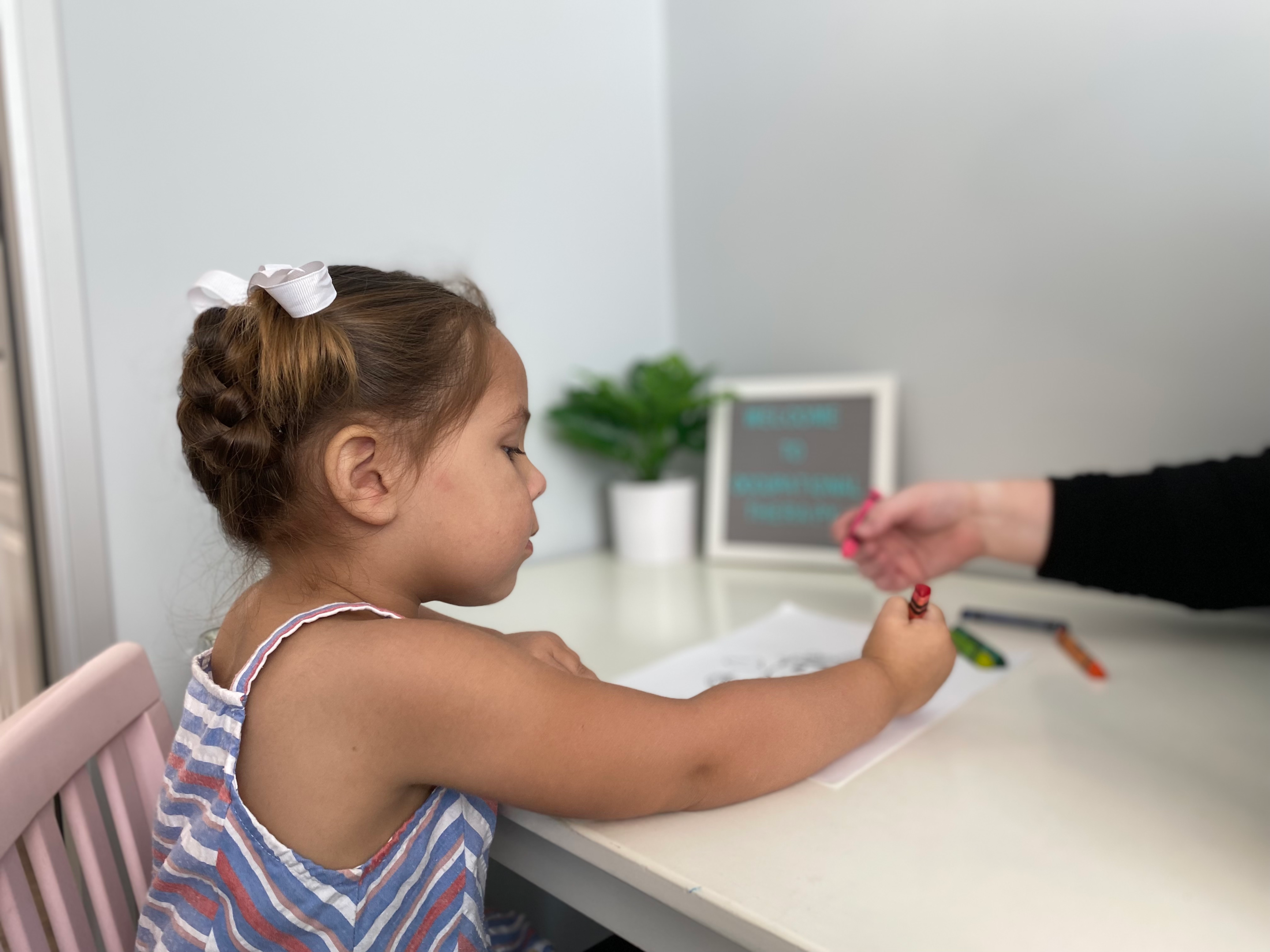Handwriting is one of the most common areas parents ask me about in my practice. It is such a necessary occupation for classroom tasks, general fine motor development, and visual perception/motor tasks. Pencil grasp development is central to legibly completing handwriting tasks and there are so many factors impacting pencil grip development and fine motor control that it can be tricky to determine when grasp patterns are ineffective and when/how to intervene.
What is a Pencil Grasp and Why is it Important?
Simply put, a pencil grasp is the way in which one holds onto a writing utensil. While I could go on and explain the technicalities of finger placement in relation to the writing tool, and how the hyperextension of different joints impacts the success of the grasp, it really is not relevant in this context. In general, an effective grasp pattern is one that does not cause fatigue quickly when writing or drawing, and that does not impact the legibility or accuracy of the work. Pencil grasp can have a large impact on the legibility of handwriting, which is a relatively large occupation for kids. Therefore, remediation of dysfunctional grasp patterns is important to academic success.
Pencil Grasp Development and Dysfunctional Pencil Grasps
As a child grows, they gain more control over coloring and writing tools, which lead to development of a mature grasp. Typically a child’s pencil grip moves from fisted (or using the entire hand to retain grasp of the tool) to digital pronate (or holding on to the top of the pencil and pointing the index finger down towards the writing tip) to a four finger or quadrupod grasp. A quadrupod grasp is where the thumb and index finger are in opposition around the pencil tip, the middle finger supports the index, and the pencil rests on the ring finger. A three finger or dynamic tripod grasp is where the thumb and index fingers are controlling the pencil movement, with the back of the pencil rest on the middle finger. Basically, it’s expected that the child holds the pencil with an “adult grasp” around age 5. There is a lot of variation in pencil grasps, and really pencil grips are dysfunctional when the child is using an immature grasp pattern or when they are using too much force or pressure when completing work.

Factors Impacting a Child’s Pencil Grip
Surprisingly, many different body systems need to work appropriately and efficiently to support a functional pencil grasp. The common areas impacting pencil grip are detailed below, however it’s by no means comprehensive. Occupational therapists work to determine if the pencil grip is dysfunctional, if intervention is warranted, and what specific areas are impacting functional grip development. Occupational therapists in both the school system and in outpatient clinics can work on fine motor skills and help your child develop an appropriate grasp.
Core Strength and Postural Control:
As an OT, they teach you “proximal stability leads to distal mobility”. In other words, you need to have strength and control in your core, shoulder and arm muscles to allow for your finger and wrist muscles to do their jobs. If you think about it, you won’t be able to write or draw anything well if you can’t sit upright in your desk, or are having to use whole arm movements to complete that drawing. If you don’t believe me, I highly encourage you to try signing your name or completing a more precise drawing activity while keeping your wrist and elbow stable, and only moving your shoulder and arm. It’s tricky, I promise. Core strength and functional strength in your shoulder and arm muscles allow for development of tool use and fine motor coordination. When remediating pencil grip, this is usually where I start.
Proprioceptive and Tactile Processing:
Proprioceptive processing and tactile processing are exceedingly important to efficient pencil grasp development. Proprioception is our body’s way of determining body awareness and body position. The receptors are located in all of our muscles and joints and are activated by stretching and contracting our muscles or applying force or resistance to our joints. This system helps other types of input integrate in the central nervous system due to the anatomical orientation of the nervous system tract. It is responsible for safety awareness, gradation of force and pressure, tool use, gross motor and fine motor coordination, and self-regulation. The tactile system is our body’s way of receiving, decoding, and reacting to touch. This system can process light touch, deep pressure (tight hugs, weighted blankets) vibration, and temperature. The main receptors are in our skin, with the highest concentration of receptors located around our mouths and fingers. Now you may be thinking that these don’t sound relevant to handwriting and hand muscles, but trust me on this. Hand muscles require the same communication from our nervous system as all other body systems do. When proprioception or tactile processing is not efficient or is unreliable, maintaining an effective grasp pattern is challenging to say the least. It can be hard to “feel” the writing tool in your hand, resulting in needing more surface contact in order to feel in control of that writing utensil. This may look like a closed web space (or the area between the thumb and index fingers is small) rather than the ideal open web space. Therefore, you may often see a fisted grasp or a variation of a four finger grasp when children who present with sensory processing differences are writing. It is not always a matter of strength, it’s maybe a matter of subcortical processing and sensory integration.
Fine Motor Strength:
Oftentimes children have limited strength, low muscle tone or limited dexterity in the small muscles of the hands, impacting their ability to maintain an appropriate grasp on a coloring tool. This is typical of children who can write one or two sentences with a dynamic tripod grip, then fatigue and switch to a less functional grasp pattern. Generally speaking, a closed fist grasp or digital pronate grasp require less strength and coordination than a tripod grasp does.
When is Pencil Grip a Problem?
Everyone uses a different type of grasp. Whether you use a thumb wrap, three fingers, four fingers, or some combination of grasp types. Pencil grasp development is important but its also important to recognize that different does not always mean wrong. Occupational therapy may be warranted when the grasp development is impacting function. If your child’s hand is getting tired quickly, or if their grasp is impacting the legibility of their handwriting, then remediation may be needed.
Tips for Adjusting Pencil Grasp at Home
While there are many different strategies for adjusting pencil grasp, here are a few of my favorites:
Pencil Grips
There are just about a million different pencil grips you can find which say they are the best for promoting a dynamic tripod grasp. I wish I could point you to a surefire brand or type that works for all kids regardless, but unfortunately that isn’t the case. Your child will likely need to try out quite a few different grips to determine which one fits their little fingers the best. Whether it’s a triangle grip, a “puppy dog” grip, or a crossover grip, see which is most comfortable for your child’s little hands and which is promoting appropriate thumb, index finger, and third finger placement.
Hiding “Treasure”
This may be one of my absolute favorite tricks. When a child is holding a crayon or pencil with a less than functional grasp, I ask them to “hide” pom poms or other small objects against their palm with their fourth finger and pinky. This will force the fingers to move into a. tripod grasp as only the thumb, index fingers and middle fingers are available to hold the pencil. Try keeping this small object in the hand for as long as tolerated, and work up to longer periods. If your child has smaller hands, use smaller objects. Remember, your child’s hands are working hard to maintain the grasp, and they may fatigue. It is okay to take breaks while the muscles build strength and develop.
Fine Motor Games
Just like other muscles in our bodies, our fine motor muscles need to develop with different stretches, exercises, and activities. In occupational therapy we often play different “warm up” games before moving to handwriting activities. This helps to wake up those muscles before we ask them to hold a pencil correctly. Your child can work on these muscles by using resistive putty to find treasures like beads or gems, placing coins into a piggy bank using their thumb and index finger to pick up the pieces, playing Mancala or opening and closing a tennis ball monster to feed him pom poms. Any activity that requires coordination of fingers and hands is likely helping develop those pencil-grasp muscles.
In summary…
Just like the rest of our body, our children develop hand strength and coordination over time. Exercising is key to developing an appropriate pencil grip. If you have concerns about the way your child is holding their pencil or crayon, it is always best to consult a trained occupational therapist. Whether or not occupational therapy is needed, the therapist can help develop specific activities your child can use to improve their pencil grip.
https://calendly.com/valuedvoices/

Kaelyn Green, MA, OTR/L
Kaelyn Green is a licensed occupational therapist at Valued Voices. She is certified by the University of Southern California in Sensory Integration and is an advocate for addressing underlying sensory functioning in order to improve occupational performance. She is passionate about meeting children and families where they are at and seeks to tailor interventions to the unique needs of her clients. When she is not working, you will find Kaelyn taking care of her two goldendoodles, working in her garden, or taking trips to the Central Coast.

